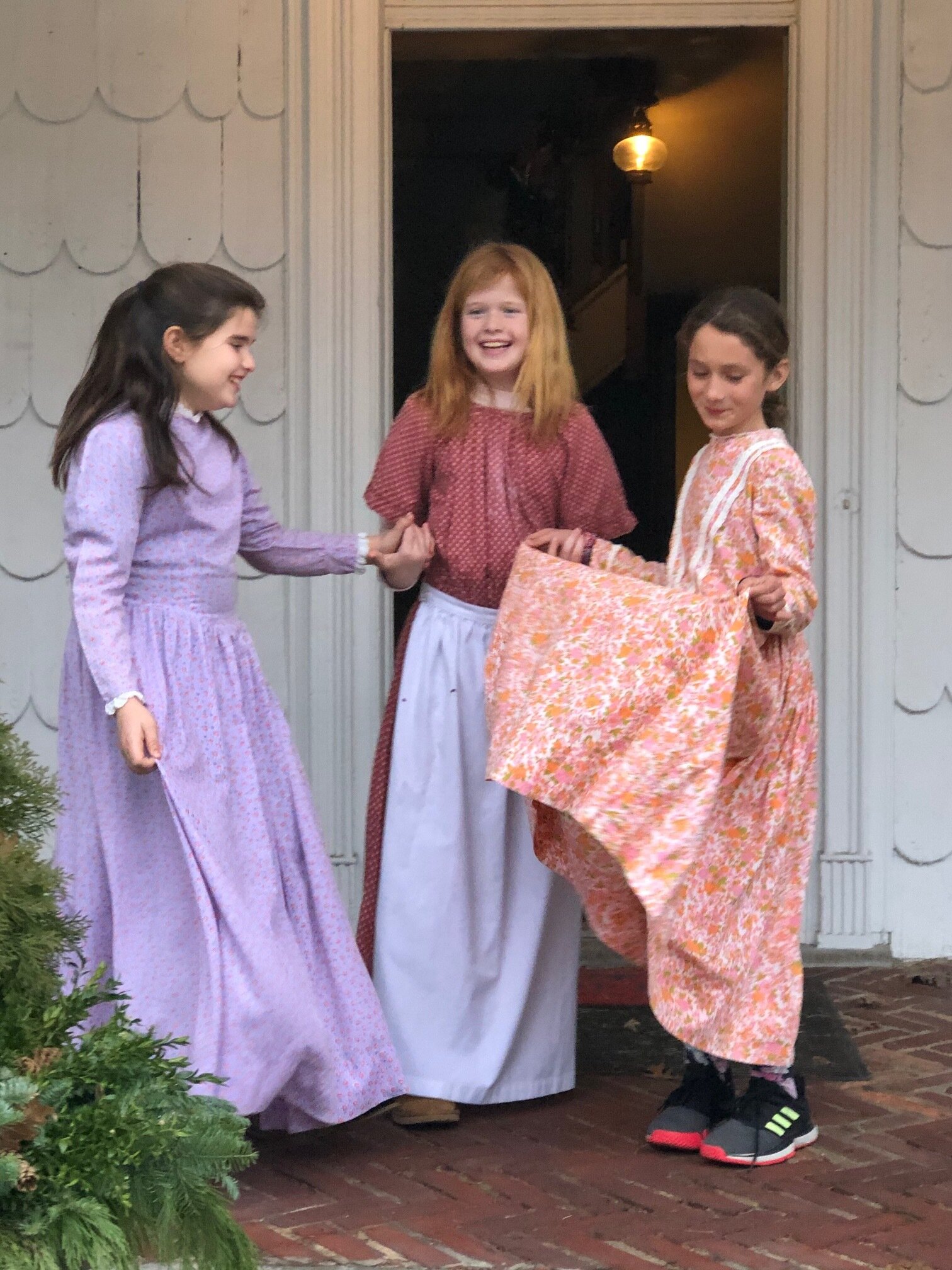Tea Time
Two weeks ago, to celebrate the launch of the new film adaptation of Little Women, we held a Little Women Tea at the Square House for families in the community. While we were planning the tea, I was overcome with Little Women nostalgia, with my three children now approaching the age I was when I first read the classic book. I had not thrown many tea parties in my life, keeping them in the category of old-fashioned activities from my grandmother’s generation, along with knitting and cross-stitch. As we planned for the party, my excitement grew with each mismatched tea set and vintage-looking tablecloth we found. Watching the two dozen children dressed in period clothing bake and socialize in the Square House, I quickly realized how important it is, particularly with our busy schedules, to make time to gather, and having a tea party is a perfect way to do this. It is a path to learn about history and make connections to our lives today, just as the film, Little Women, helps us connect to life long ago and relive classic literature.
While still enjoying the energy and high spirits of the afternoon tea, I ran into a friend in Rye and started talking. As I’m sure many of you know firsthand, when people in Rye start talking, ideas come together, and good things can happen. This was one of those times. My friend Larry told me about his daughter, Anne, who moved back to the area recently from San Francisco, and who happens to be a tea expert and a history buff. She loves tea and tea parties so much that she recently started her own tea company. With my newfound interest in tea parties and lack of knowledge in the subject, I connected with Anne, whose passion for and research in the interconnection between tea and history is limitless. I’ve only begun to scratch the surface,and look forward to learning more from our local expert. In this latest Rye Story, Anne Rowen shares a bit of this history with us, just as our country is celebrating the 100th anniversary of the 19th Amendment. Be sure to pay attention to the ads at the end!
EqualiTea: A quick look into the intertwined history of tea and equality
by Anne Rowen, Founder, Tea Party Trash
While today we might associate taking tea with a carefree, fanciful, and conservative afternoon, throughout history, tea has proved time and time again to be not only a catalyst for social and political change, but also at the very center of pivotal moments in history.
How can a simple traditional drink be so radical?
For starters, tea was the main focus of one of the most famous protests of all time, the Boston Tea Party. Frustrated with the tax from Britain on essential items such as tea, the Sons of Liberty famously dumped 342 chests of tea into Boston Harbor. Today, that would have been nearly $1,000,000 worth of imported tea.
Jumping forward in history, in the mid 1800s, the price of tea dramatically dropped as trade between the US and China opened up and tea’s popularity skyrocketed. The act of taking tea as a social event was quickly catching on with all social groups and classes, but specifically among women. While men and women mixed and took tea together, it wasn’t long before women took tea into their own hands and started throwing high teas, low teas, and afternoon teas just for themselves.
Gathering for tea was one of the first acceptable ways for women to come together outside of the home. Even if men were present, the tea table provided a safe space to sit, talk, and listen to each other. At a time when the majority of taverns and pubs were off-limits to women, teas enabled women to have a voice and exchange ideas.
Advertisement for Equality Brand Tea, created as a fundraising effort by the Woman’s Suffrage Party of California
Tea provided the perfect social cover up for groups of ambitious women to start complaining. Perhaps the best example of this is when Jane Hunt invited four friends over for tea: Elizabeth Cady Stanton, Lucretia Mott, Martha Wright, Mary Ann Accintook.
As the women sipped their tea they started to talk about how angry they were with the state of women’s rights. In her Diary Elizabeth Cady Stanton recalled the tea party, saying, “I poured out, that day, the torrent of my long-accumulating discontent.” It is said that after leaving the tea party Mott and Stanton vowed to hold a convention to discuss women’s rights. They wrote an ad in the paper and 10 days later on July 19, 1848 held the first day of the Seneca Falls Convention. During the convention, the hundreds of attendees produced the Declaration of Sentiments that would inspire and kickstart the women’s suffrage movement.
Advertisement for the Seneca Falls Convention
As the women’s movement grew, tea remained at the heart of it. Local suffrage groups would often hold their meetings over tea because it was socially acceptable. Suffragists also relied on tea for fundraising. Women’s groups would throw elegant and elaborate tea parties to raise money and increase awareness. In San Francisco, a suffragist group famously started packaging and selling ‘Equality Tea,’ with proceeds from the tea of course going to the cause.
Who knew what plans could be brewing under the guise of an innocent afternoon tea? Teas are much more than leisure time activities. These social gatherings provide the creative space and personal connection from which new ideas can grow. Perhaps we all need some more tea parties in our lives.
If you missed the first Little Women Tea, we are hosting one again on February 8th. Register here.




